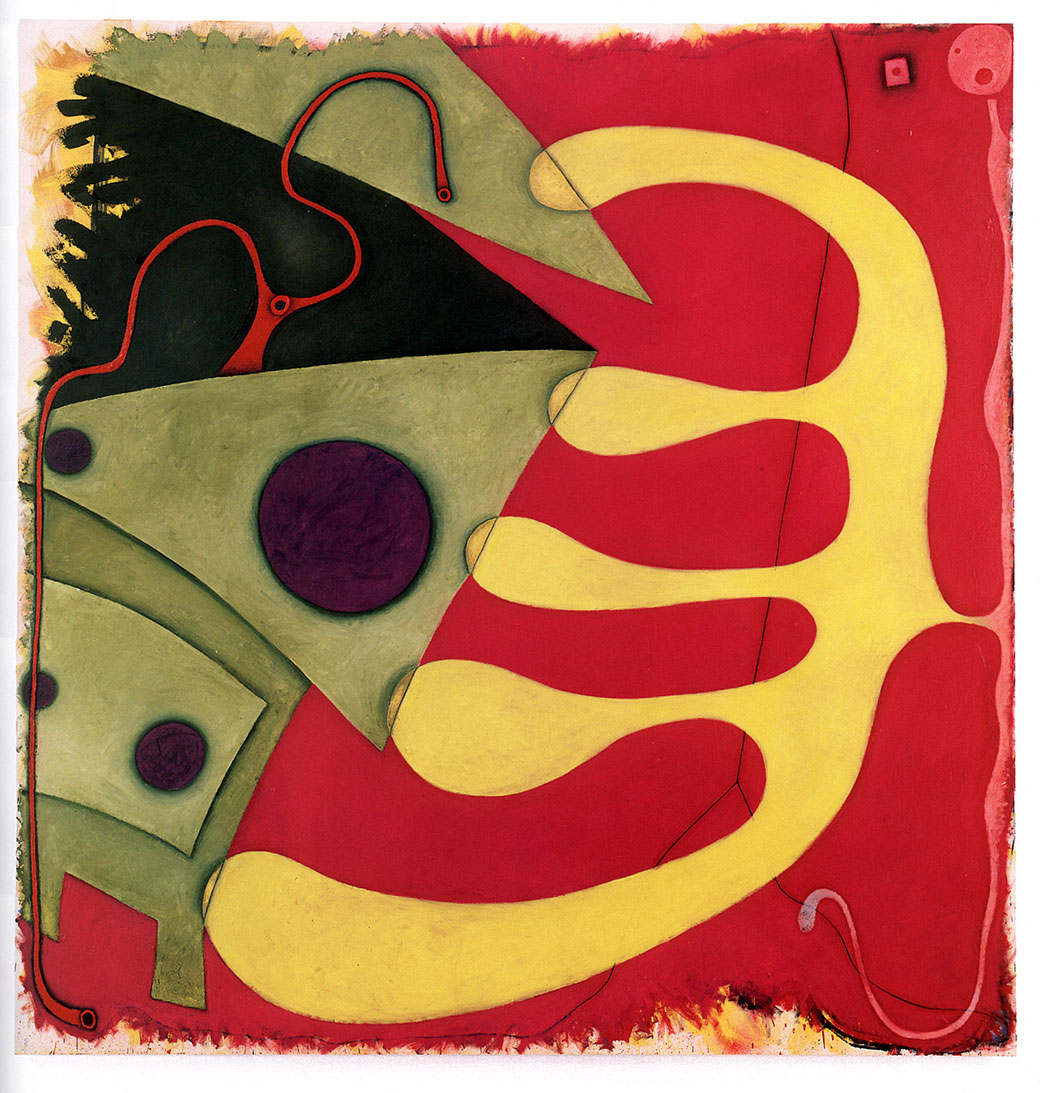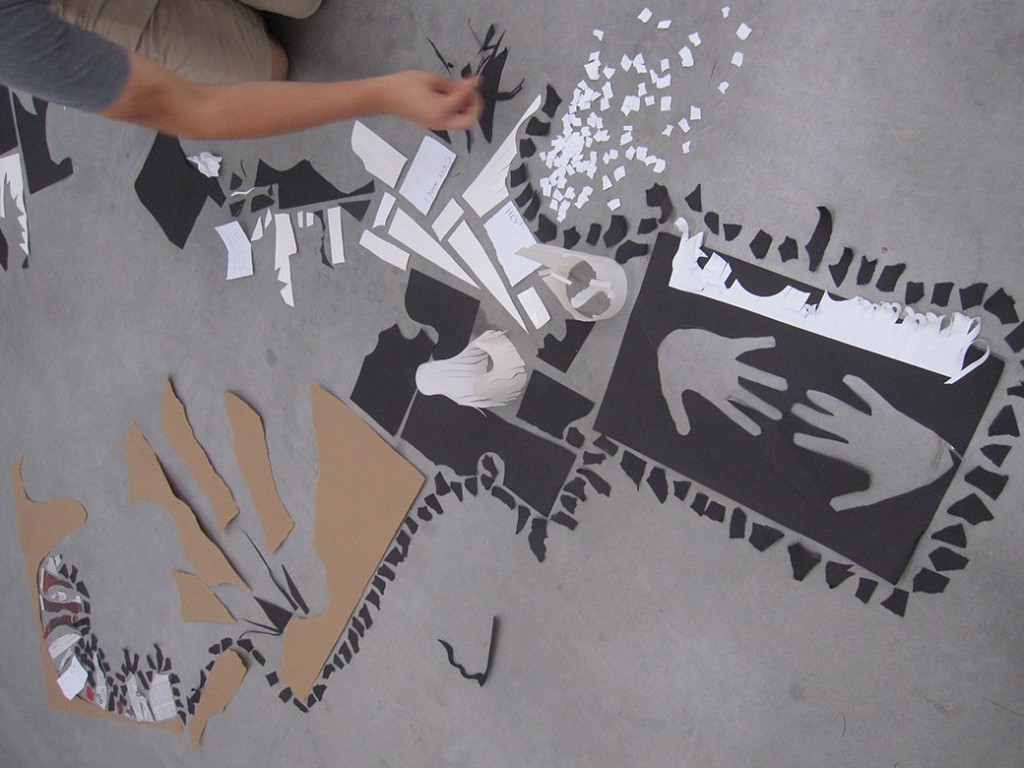
Elizabeth Murray. Open Drawer, 1998. Oil on canvas; 112 x 108 inches. Photo: Ellen Page Wilson. Courtesy Pace Gallery, New York.
Sixth grade students work on abstract narratives based on the work of Elizabeth Murray. Photo: Karen Melvin.
Visual art education has been alternately influenced by two very different historical legacies and ideologies. One school of thought privileges unfettered creativity and self-expression: All art is valid because the artist made it, and everyone can be an artist. The other school privileges and hones specific skills, methods, and values: Elements and principles of design dictate the building blocks of curricula that one must utilize and understand in order to be deemed a good artist. These seemingly contradictory schools have reinforced unrealistic and inaccurate notions of what an artist is and does as well as what good art is and should look like.
The emphasis on modernist approaches and a simplistic focus on elements and principles of design has been the reigning definition of school-based art for decades. Students complete color wheels, study works by the great masters (who are mostly dead, white, and male), and utilize mimicry to copy images of all sorts that then colorfully adorn our refrigerators.
In many schools today, we still teach that great artists all look the same, that for the most part they are no longer alive, and that all you need to do to be like them is to copy their styles and techniques. This kind of standardization in the arts has created generations of poor forgers or worse: dispirited adults who swear they lack any creative or artistic ability because they couldn’t accurately stipple, crosshatch, or represent the volume of an apple. Such skills are useful for certain approaches to art. But are these the primary, or even secondary skills of artists working today?
Laylah Ali. Production still from ART21 Exclusive film Laylah Ali: Meaning. © Art21, Inc., 2009
Fifth grade students enact their own painting restraints based on the work of Matthew Barney. Photo: Maureen Hergott and Julia Mack
Earlier this year, the National Coalition for Core Arts Standards (NCCAS) made a comprehensive overhaul of the National Standards for Art Education, which were originally written in 1994 and organized by the US Department of Education, the National Endowment for the Arts, and the National Endowment for the Humanities. The new visual-arts standards effectively replace the broad 1994 ones as well as many sets of state arts standards that had been used with limited and scattered success for years.
The interesting thing about standards is that they are premised on standardization: principles undeniable under the auspices of equity and fair access to public education across diverse demographics, income brackets, cultural differences and divides. But standardization can signal the death of dynamic teaching. Thus the paradox: how does one create standards that empower teachers and don’t quash creativity, individuality, and the students themselves? The radical educator Paolo Freire came up with the term “banking models” to describe traditional education systems that rely on the teacher depositing standardized information into students’ heads and then expecting them to regurgitate it in answers to test questions or other rote exercises. Standards don’t just determine what should be taught; they also often mandate how teaching will happen. This is the crux of the dilemma between standards and standardization.
The paradox is especially severe as we, visual-art educators, struggle to redefine ourselves—our values and the ways in which we can support dynamic learning in and through the arts now and in the twenty-first century.
David Altmejd. Production still from the ART21 Art in the Twenty-First Century Season 6 episode, Boundaries. © Art21, Inc., 2012.
Fifth grade students enact their own painting restraints based on the work of Matthew Barney. Photo: Maureen Hergott and Julia Mack
In previous issues of the ART21 Magazine we have addressed revolution in education, have thought about how to integrate contemporary artists, and have suggested different approaches and themes that might guide our thinking. The new NCAAS standards show that, finally, there may be a shift.
The new standards focus on four artistic processes—Creating, Presenting, Responding, and Connecting—and eleven anchor standards driven by specific understandings and essential questions. When one compares this model with the previous set of standards, one sees not only similarities but also distinct differences (see a comparison here). While both the 1994 and the new standards share an emphasis on knowledge, skills, and philosophical foundations, there is a new focus on contemporary approaches to art-making and visual literacy, as well as the exploration of questions versus the consumption of pre-existing knowledge. Strategies like collaboration, concepts of ethics and social responsibility, and a focus on process rather than products are clearly visible. The new standards present a lot to be optimistic about, especially when one considers how art is being made now.
For example, ART21-featured artists describe their practices in a myriad ways. Arturo Herrera and William Kentridge talk about the significance of failure and reinvention for their work. Thomas Hirschhorn and Tania Bruguera are committed to engaging audiences in timely social issues by creating new social structures and platforms. Maya Lin has an interdisciplinary practice and uses her work as an artist to investigate ecological topics, methods, and questions. David Altmejd rarely knows what he will make when he begins a project and uses intuition, play, and experimentation to shape the process and the result. In her work, Laylah Ali addresses racial, social, political, and economic inequity to generate dialogue and broaden awareness. These artists create a level of ambiguity or not knowing within their practices that can empower us as educators to do our own thinking while expanding our awareness of the world. In the new season of ART21 Art in the Twenty-First Century, the artist Trevor Paglen says, “Art is more than a series of images that are disembodied…Art [lives] in real places, economies, spaces, [and] architecture.”
